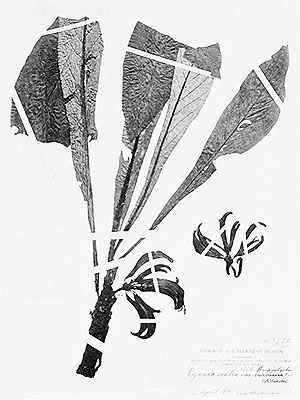Blue Hole Cyanea (Cyanea dolichopoda)
The Blue Hole Cyanea was discovered in 1990 on the island of Kaua’i, Hawaiian Islands, in an extremely inaccessible locality known as ‘The Blue Hole’, located at the headwaters of the Wailua River east of Kaua’i’s center, a deep and extremely wet valley head surrounded on three sides by vertical cliffs 900 m high and laced with waterfalls.
The vegetation at this place comprises an unusual mix of shrubland and low rainforest with a canopy only 1 to 3 m tall and a very rich ground layer of ferns, only a single mature and three juvenile plants were found.
The Blue Hole Cyanea is a 1 m tall, unbranched shrub.
The leaves bear a 9 to 16 cm long petiole, the laminas are up to 10 cm long and 3,7 to 5,8 cm wide, their upper surface is green and glabrous, the lower surface is light green and bears scattered hairs along the midrib. The leaf the base is cordate, often markedly asymmetric, the margins are callose-serrulate, the apex is acute or obtuse. The only adult plant was found with not fully-developed flowers; thus, the fully expanded flowers or fruits are unknown. [1]
***
The type locality was visited again in 1992, six weeks after Hurricane Iniki severely struck Kaua’i, all known individuals were found destroyed by the hurricane.
The species was than described only one year later.
It is somewhat possible that additional plants exist, however, the almost complete inaccessibility of the type locality makes it quite unlikely that it will soon be explored. [1]
*********************
References:
[1] Thomas G. Lammers; David H. Lorence: A new species of Cyanea (Campanulaceae: Lobelioideae) from Kaua’i, and the resurrection of C. remyi. Novon 3: 431-436. 1993
*********************
edited: 03.04.2018


